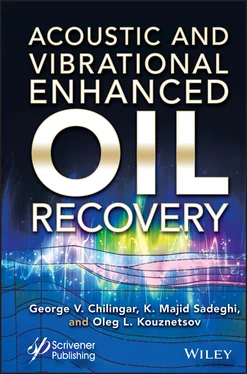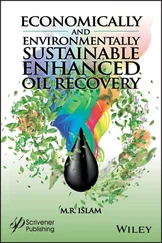Δ = ρ n/ ρ cis the density ratio of the nonwetting to the wetting liquids.
Due to a greater mobility of the nonwetting liquid relative to wetting one, the effective density of liquid mixture at vibration lower than the density in a dormant state by a positive value ρ′. Power that needs to be expended for the vibration support of a unit pore volume is N = K A 2/2. For the most practically important cases  . The equations for the displacement amplitudes are:
. The equations for the displacement amplitudes are:

These equations show that non-wetting liquid’s relative displacement maximum amplitudes A rare greater, the greater the difference between its density and the density of wetting phase, the non-wetting liquid’s vibration is leading in phase the vibration of the wetting liquid. At absolute motion, of the non-wetting liquid, the absolute amplitudes of displacement exceed those of wetting one.
As the equivalent viscosity at certain conditions may exceed by one order of magnitude (and even greater) the wetting liquid’s viscosity, the vibration penetration depth for a liquids’ mixture may be significantly greater. Various equations have been proposed for calculating effective dynamic viscosity factor. For example, at 30% content of nonwetting phase, the effective dynamic viscosity factor is almost three times greater than the similar viscosity factor for a wetting liquid. Appropriately, the mixture’s kinematic viscosity is 1.4 times greater than for the wetting phase. Thus, the penetration depth is 1.4 times greater than in wetting phase.
Some qualitative patterns (regularities) in vibration’s penetration into a unconsolidated reservoir for the simplest case of circular vibrations follow from the solution of motions by a material particle touching a flat surface. If the surface vibration acceleration

where ω is the frequency, A is the radius of circular vibration trajectory, f is the slipping friction factor, and g is the gravity acceleration, then the particle is moving together with the vibrating surface.
At Aω 2˃ fg , the particle acceleration W , velocity U , and trajectory radius r at steady absolute motion are defined by the following equations:
(2.29) 
i.e., the trajectory velocity and radius rapidly decline with growing frequency.
At sufficiently large surface vibration frequency, the particle remains practically immobile in space. This pattern is manifested to some extent also at vibratory motions of unconsolidated reservoir layers. There is some range of the surface vibration accelerations, within which vibration penetrates the reservoir in a certain most efficiently.
A basic assumption is explaining the motion of one relative to another of the elementary layers composing the reservoir is that the dry friction factor f between the layers is considered a function of the normal overburden pressure, i.e., the weight of the overlying layer. This is supported by a series of direct and indirect experiments by Yamshchikov [27]. Designating the overlying layer weight per unit area as G , the relationship between the dry friction force F (“resistance force to a relative layers’ displacement”) and G and f values is as follows:
(2.30) 
where f ( G ), according to our assumption, is some increasing G function. Then, at a growth of vibrating surface vibration acceleration Aω 2, the motion looks as follows.
At Aω 2=( Aω 2) 1˂ gfl , where fl is the value of friction factor at the upper boundary of the layer, all layer’s particles move together with the vibrating surface as one solid body. After the acceleration exceeds, the Aω 2value, relative sliding begins of the upper layer’s part on the lower one. It continues moving together with the vibrating surface. At further increase of the acceleration, the relative motion expands over the underlying layers and at

reaches the lower boundary of the reservoir (subscript mbelongs with values related to this boundary). At Aω 2 > ( Aω 2) 2, the entire reservoir is sliding relative the vibrating surface (sliding variously at different levels). The particles’ absolute velocity at this layer is decreasing from the lower boundary to the upper one. Velocity moduli at the points with certain G values are found as
(2.31) 
If the particles’ material is uniform in the reservoir, then the value u ,

(where x is absolute coordinate, G mis the total weight of the larger per vibrating surface unit area, and h is the reservoir thickness), is a relative coordinate counted measured vertically down from the reservoir upper boundary. If the correlation of friction factor f with G is linear, then Equation (2.31)becomes
(2.32) 
where ξ = f m − f 0/ f 0>0 is the relative difference of friction factors at the lower and upper reservoir boundaries. At these boundaries
(2.33) 
The former equation is equivalent to Equation for a particle velocity if the friction factor f is replaced with its f 0value for the upper boundary of the reservoir. The other patterns of vibration’s penetration for the subject model of an unconsolidated reservoir are also similar to those established for the particle. Maximum vibration acceleration of the reservoir particles

is reached at its lower boundary at the same value of the vibration acceleration of the surface Aω 2 = ( Aω 2) 2. At the further increase of A ω 2increase, the reservoir particles accelerations remain unchanged, whereas the velocity and the trajectory radius at a constant vibration amplitude decline with the increase in frequency. Thus, with increasing surface acceleration vibrations Aω 2 ˂ ( Aω 2) 1= gf 0, the vibrations completely penetrate the entire reservoir thickness, and at Aω 2 ˃ ( Aω 2) 1, they do only partially. The “penetrating acceleration” with its increasing value A ω 2stabilize at the gf 0level for the upper reservoir’s boundary, and “the velocity and amplitude penetration” declines with increasing frequency, in proportion to ω and ω 2.
Читать дальше

 . The equations for the displacement amplitudes are:
. The equations for the displacement amplitudes are:




















